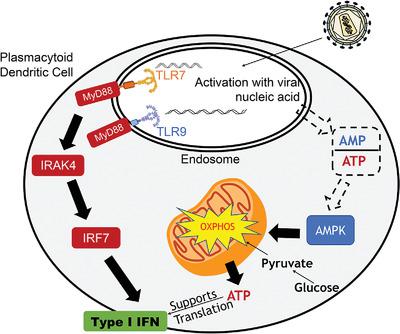当前位置:
X-MOL 学术
›
J. Leukoc. Biol.
›
论文详情
Our official English website, www.x-mol.net, welcomes your
feedback! (Note: you will need to create a separate account there.)
Frontline Science: AMPK regulates metabolic reprogramming necessary for interferon production in human plasmacytoid dendritic cells
Journal of Leukocyte Biology ( IF 3.6 ) Pub Date : 2020-07-08 , DOI: 10.1002/jlb.3hi0220-130 Harry J Hurley 1, 2 , Hannah Dewald 2 , Zachary S Rothkopf 2 , Sukhwinder Singh 1 , Frank Jenkins 3 , Pratik Deb 2 , Saurav De 2, 3 , Betsy J Barnes 3, 4 , Patricia Fitzgerald-Bocarsly 1, 2
Journal of Leukocyte Biology ( IF 3.6 ) Pub Date : 2020-07-08 , DOI: 10.1002/jlb.3hi0220-130 Harry J Hurley 1, 2 , Hannah Dewald 2 , Zachary S Rothkopf 2 , Sukhwinder Singh 1 , Frank Jenkins 3 , Pratik Deb 2 , Saurav De 2, 3 , Betsy J Barnes 3, 4 , Patricia Fitzgerald-Bocarsly 1, 2
Affiliation

|
Plasmacytoid dendritic cells (pDCs) play a crucial role in innate viral immunity as the most potent producers of type I interferons (IFN) in the human body. However, the metabolic regulation of IFN production in such vast quantity remains poorly understood. In this study, AMP‐activated protein kinase (AMPK) is strongly implicated as a driver of metabolic reprogramming that the authors and others have observed in pDCs after activation via TLR7/9. Oxygen consumption and mitochondrial membrane potential (MMP) were elevated following stimulation of pDCs with influenza or herpes simplex virus. Blocking these changes using mitochondrial inhibitors abrogated IFN‐α production. While it appears that multiple carbon sources can be used by pDCs, blocking pyruvate metabolism had the strongest effect on IFN‐α production. Furthermore, we saw no evidence of aerobic glycolysis (AG) during pDC activation and blocking lactate dehydrogenase activity did not inhibit IFN‐α. TLR7/9 ligation induces a posttranslational modification in Raptor that is catalyzed by AMPK, and blocking TLR7/9 before virus introduction prevents this change. Finally, it is demonstrated that Dorsomorphin, an AMPK inhibitor, inhibited both IFN‐α production and MMP in a dose‐dependent manner. Taken together, these data reveal a potential cellular mechanism for the metabolic reprogramming in TLR 7/9‐activated pDCs that supports activation and IFN‐α production.
中文翻译:

Frontline Science:AMPK 调节人浆细胞样树突状细胞干扰素产生所必需的代谢重编程
浆细胞样树突状细胞 (pDC) 作为人体内最有效的 I 型干扰素 (IFN) 生产者,在先天病毒免疫中起着至关重要的作用。然而,如此大量的 IFN 产生的代谢调节仍然知之甚少。在这项研究中,AMP 活化蛋白激酶 (AMPK) 与作者和其他人在通过 TLR7/9 激活后的 pDC 中观察到的代谢重编程的驱动因素密切相关。用流感病毒或单纯疱疹病毒刺激 pDC 后,耗氧量和线粒体膜电位 (MMP) 升高。使用线粒体抑制剂阻断这些变化可消除 IFN-α 的产生。虽然 pDC 似乎可以使用多种碳源,但阻断丙酮酸代谢对 IFN-α 产生的影响最强。此外,我们没有看到 pDC 激活期间有氧糖酵解 (AG) 的证据,并且阻断乳酸脱氢酶活性不会抑制 IFN-α。TLR7/9 连接在 Raptor 中诱导由 AMPK 催化的翻译后修饰,在病毒引入之前阻断 TLR7/9 可防止这种变化。最后,证明了 Dorsomorphin,一种 AMPK 抑制剂,以剂量依赖的方式抑制 IFN-α 的产生和 MMP。综上所述,这些数据揭示了 TLR 7/9 激活的 pDC 中支持激活和 IFN-α 产生的代谢重编程的潜在细胞机制。在病毒引入之前阻止 TLR7/9 可以防止这种变化。最后,证明了 Dorsomorphin,一种 AMPK 抑制剂,以剂量依赖的方式抑制 IFN-α 的产生和 MMP。综上所述,这些数据揭示了 TLR 7/9 激活的 pDC 中支持激活和 IFN-α 产生的代谢重编程的潜在细胞机制。在病毒引入之前阻止 TLR7/9 可以防止这种变化。最后,证明了 Dorsomorphin,一种 AMPK 抑制剂,以剂量依赖的方式抑制 IFN-α 的产生和 MMP。综上所述,这些数据揭示了 TLR 7/9 激活的 pDC 中支持激活和 IFN-α 产生的代谢重编程的潜在细胞机制。
更新日期:2020-07-08
中文翻译:

Frontline Science:AMPK 调节人浆细胞样树突状细胞干扰素产生所必需的代谢重编程
浆细胞样树突状细胞 (pDC) 作为人体内最有效的 I 型干扰素 (IFN) 生产者,在先天病毒免疫中起着至关重要的作用。然而,如此大量的 IFN 产生的代谢调节仍然知之甚少。在这项研究中,AMP 活化蛋白激酶 (AMPK) 与作者和其他人在通过 TLR7/9 激活后的 pDC 中观察到的代谢重编程的驱动因素密切相关。用流感病毒或单纯疱疹病毒刺激 pDC 后,耗氧量和线粒体膜电位 (MMP) 升高。使用线粒体抑制剂阻断这些变化可消除 IFN-α 的产生。虽然 pDC 似乎可以使用多种碳源,但阻断丙酮酸代谢对 IFN-α 产生的影响最强。此外,我们没有看到 pDC 激活期间有氧糖酵解 (AG) 的证据,并且阻断乳酸脱氢酶活性不会抑制 IFN-α。TLR7/9 连接在 Raptor 中诱导由 AMPK 催化的翻译后修饰,在病毒引入之前阻断 TLR7/9 可防止这种变化。最后,证明了 Dorsomorphin,一种 AMPK 抑制剂,以剂量依赖的方式抑制 IFN-α 的产生和 MMP。综上所述,这些数据揭示了 TLR 7/9 激活的 pDC 中支持激活和 IFN-α 产生的代谢重编程的潜在细胞机制。在病毒引入之前阻止 TLR7/9 可以防止这种变化。最后,证明了 Dorsomorphin,一种 AMPK 抑制剂,以剂量依赖的方式抑制 IFN-α 的产生和 MMP。综上所述,这些数据揭示了 TLR 7/9 激活的 pDC 中支持激活和 IFN-α 产生的代谢重编程的潜在细胞机制。在病毒引入之前阻止 TLR7/9 可以防止这种变化。最后,证明了 Dorsomorphin,一种 AMPK 抑制剂,以剂量依赖的方式抑制 IFN-α 的产生和 MMP。综上所述,这些数据揭示了 TLR 7/9 激活的 pDC 中支持激活和 IFN-α 产生的代谢重编程的潜在细胞机制。











































 京公网安备 11010802027423号
京公网安备 11010802027423号